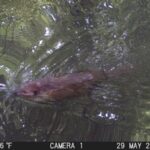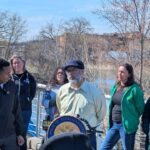When José the Beaver was spotted building his lodge on the Bronx River in the winter of 2007, it was a proud moment for the Bronx River Alliance, a vote of confidence in its efforts to restore the river. It had been perhaps two centuries since wild beavers were last seen in New York City, but the Bronx River had a long relationship with beavers before that.
Beavers were of course what led the Dutch to found the city of New Amsterdam at the tip of Manhattan Island in the 1620s. While the focus of the beaver trade was up the Hudson at Fort Orange (present-day Albany,) the lower Hudson Valley, and the Bronx River, did supply a modest stream of beaver skins in the early years of New Amsterdam.
The Aquahung, or Bronx River, was noted for its abundance of beavers. Their dams and ponds dotted the course of the river, and in places altered it. By some accounts the northern reach of the river around White Plains was compared to a string of beads, from the succession of beaver dams and ponds along its length. One large beaver pond near Scarsdale even became the site of one of the first water-powered mills in the area.
European demand for beaver skins depleted the beaver population in the Bronx River long before New Amsterdam became New York in 1664, but a small population of beavers managed to hang on along the upper reaches of the river until about the end of the 1700s.
— S.P. DeVillo





